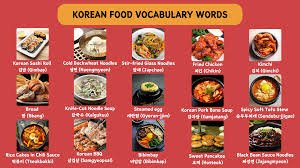
korean food names
Introduction: Why Learn Korean Food Names?
Whether you’re planning a trip to Seoul, dining at a Korean restaurant, or simply exploring global cuisines, knowing Korean food names helps you understand the culture and order confidently. Korean cuisine is rich, flavorful, and deeply traditional, with dishes that span from spicy stews to grilled meats and delicate pancakes. This guide will introduce you to 30 essential Korean food names, their meanings, and what to expect when they show up on a menu.
1. Kimchi (김치)
Kimchi is the most iconic Korean dish, made from fermented cabbage or radish mixed with chili, garlic, and other seasonings. Served with almost every meal, it’s spicy, sour, and loaded with probiotics.
2. Bibimbap (비빔밥)
Bibimbap literally means “mixed rice.” It’s a rice bowl topped with vegetables, egg, beef (optional), and gochujang (chili paste). Mix it all before eating for the perfect bite.
3. Bulgogi (불고기)
Bulgogi, or “fire meat,” is thin slices of marinated beef, grilled or pan-fried. The marinade includes soy sauce, sugar, sesame oil, and garlic. It’s tender and packed with flavor.
4. Samgyeopsal (삼겹살)
Samgyeopsal means “three-layered pork,” referring to pork belly grilled at the table. Wrap it in lettuce with garlic, sauces, and kimchi for a classic Korean BBQ experience.
5. Tteokbokki (떡볶이)
Tteokbokki is made of chewy rice cakes in a spicy, slightly sweet red chili sauce. It’s a favorite Korean street food, often served with fish cakes and boiled eggs.
6. Japchae (잡채)
Japchae is a noodle dish made from sweet potato starch noodles (dangmyeon), stir-fried with vegetables, beef, and a light soy-sesame sauce. It’s soft, slightly sweet, and served at celebrations.
7. Naengmyeon (냉면)
Naengmyeon are cold buckwheat noodles served in icy broth or with a spicy sauce. It’s refreshing and perfect for summer.
8. Soondubu Jjigae (순두부찌개)
Soondubu jjigae is a hot, spicy stew made with soft tofu, seafood or meat, and vegetables. Served in a stone pot with a raw egg cracked on top.
9. Kimchi Jjigae (김치찌개)
A hearty stew made with aged kimchi, tofu, pork, and sometimes noodles. Kimchi jjigae is a staple in Korean homes.
10. Doenjang Jjigae (된장찌개)
Doenjang jjigae is a fermented soybean paste stew. Earthy, umami-rich, and comforting, it’s typically made with tofu, zucchini, and mushrooms.
11. Gimbap (김밥)
Gimbap looks like sushi but is different. Seaweed-wrapped rice rolls filled with vegetables, egg, and sometimes meat or tuna. Perfect for lunch on the go.
12. Mandu (만두)
Mandu are Korean dumplings. They can be steamed, fried, or boiled and are filled with pork, beef, tofu, or vegetables.
13. Banchan (반찬)
Banchan refers to the many small side dishes served with Korean meals. Common examples include kimchi, spinach (sigeumchi-namul), and spicy cucumbers (oi muchim).
14. Haemul Pajeon (해물파전)
Haemul pajeon is a savory pancake made with green onions and seafood. Crispy, chewy, and perfect with dipping sauce.
15. Hotteok (호떡)
Hotteok is a sweet pancake filled with brown sugar, cinnamon, and nuts. Popular as a winter street food.
16. Dakgalbi (닭갈비)
Dakgalbi is spicy stir-fried chicken with cabbage, rice cakes, and gochujang sauce. Cooked on a large pan at the table.
17. Haejang-guk (해장국)
Known as “hangover soup,” haejang-guk is made from beef broth, cabbage, and congealed blood cubes. It’s spicy and healing after a night of drinking.
18. Galbi (갈비)
Galbi are beef or pork short ribs, marinated and grilled. A premium BBQ dish with deep, smoky sweetness.
19. Yangnyeom Chicken (양념치킨)
Yangnyeom chicken is Korean fried chicken coated in spicy-sweet red sauce. It’s crispy, juicy, and loved worldwide.
20. Kongguksu (콩국수)
A summer dish of cold soy milk broth with noodles. Kongguksu is creamy, mild, and refreshing—popular among vegetarians.
21. Budae Jjigae (부대찌개)
Also called “army stew,” budae jjigae is made with kimchi, spam, sausages, ramen noodles, and cheese. It’s a fusion dish born after the Korean War.
22. Jajangmyeon (자장면)
Jajangmyeon are wheat noodles topped with black bean sauce, pork, and vegetables. A comfort food especially popular during Korean moving day.
23. Sannakji (산낙지)
Sannakji is raw octopus, sliced and served while still moving. It’s a rare dish for adventurous eaters.
24. Hwe (회)
Hwe is Korean-style raw fish, similar to Japanese sashimi. Often served with spicy gochujang-based dipping sauce.
25. Gamjatang (감자탕)
Gamjatang is a spicy pork bone soup with potatoes, perilla leaves, and vegetables. Rich and perfect in cold weather.
26. Seolleongtang (설렁탕)
Seolleongtang is a milky beef bone soup simmered for hours. Mild in flavor, served with rice and kimchi.
27. Jumeokbap (주먹밥)
Jumeokbap means “fist rice”—hand-shaped rice balls often filled with tuna, kimchi, or seaweed flakes. Easy to make and eat.
28. Eomuk (어묵)
Eomuk, or fish cakes, are often served on skewers in hot broth. A popular street snack during winter.
29. Miyeokguk (미역국)
Miyeokguk is seaweed soup, traditionally eaten on birthdays or after childbirth. Light, nutritious, and soothing.
30. Gochujang (고추장)
Not a dish but essential to Korean cooking, gochujang is a red chili paste made from fermented soybeans, glutinous rice, and red pepper powder. It’s used in sauces, marinades, and soups.
Tips for Reading Korean Food Menus
When reading Korean menus:
- Words ending in -jjigae are stews
- Words ending in -guk or -tang are soups
- Bap means rice
- Myeon means noodles
- Gui indicates grilled dishes
- Jeon is a type of Korean pancake
Menus may include pictures, but learning these food names makes your dining experience smoother and more enjoyable.
For pronunciation help and recipes, check out Maangchi’s Korean food glossary.
Conclusion: Explore Korean Food One Name at a Time
Learning Korean food names opens the door to one of the world’s most vibrant culinary traditions. Whether you’re visiting Korea or dining locally, recognizing names like kimchi, bulgogi, and sundubu jjigae helps you make informed and adventurous choices. From fermented flavors to sizzling BBQ and hearty stews, Korean food offers depth, history, and pure deliciousness. Next time you’re at a Korean restaurant, try ordering by name—you’ll feel more confident, and your taste buds will thank you.






